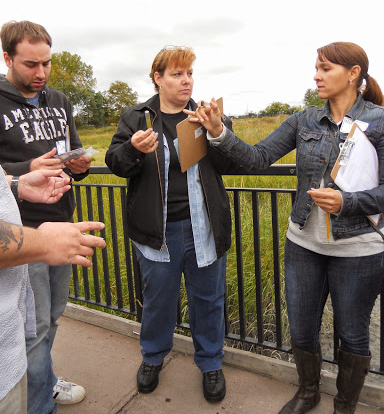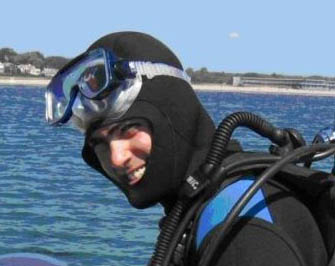
NYC middle school teachers at the “Climate Change and the Long Island Sound Estuary” teacher workshop that was held on October 2, 2014 test the water quality of Alley Pond Creek. Alley Pond Creek flows into Little Neck Bay, which discharges to Long Island Sound. Photo: Amy Mandelbaum, NYSG/LISS.
Stony Brook, NY, November 10, 2014 - At a recent New York Sea Grant sponsored climate change teacher workshop (see NYSG's related news item, "Hands-On Teacher Workshops a 'Re-Sounding' Success"), Dr. K. was asked a really interesting question about human caused changes in Long Island Sound
Q: How has the Long Island Sound changed over the years? What are the future predictions for the Sound? How is climate change influencing these changes?
A: Dr. K: This is a really broad question. Long Island Sound is constantly changing. Some changes happen on the scale of thousands to millions of years, caused by geological processes (rock weathering, glacial advance/recession, etc…) or gradual natural fluctuations in earth’s climate. I’m not really going to focus on those, but rather on changes caused by humans.
 One of the biggest changes over the last century or so has to do with altering land use. Land use changes occur when we change natural habitats (forest, salt marsh, grassland) into engineered habitats (buildings, roads, lawns, agricultural fields, etc…). Since humans tend to like to live by water, this has resulted in the loss of a great deal of coastal wetlands, among other things, which have been filled in to make them suitable to build on. These wetlands are critical habitats for birds, fish, and invertebrates. Climate change makes this issue worse, because sea level rise threatens to drown salt marshes, and human activities (roads and buildings) prevent the marshes from retreating to higher ground (a process called marsh migration), which is their usual response to changes in sea level.
One of the biggest changes over the last century or so has to do with altering land use. Land use changes occur when we change natural habitats (forest, salt marsh, grassland) into engineered habitats (buildings, roads, lawns, agricultural fields, etc…). Since humans tend to like to live by water, this has resulted in the loss of a great deal of coastal wetlands, among other things, which have been filled in to make them suitable to build on. These wetlands are critical habitats for birds, fish, and invertebrates. Climate change makes this issue worse, because sea level rise threatens to drown salt marshes, and human activities (roads and buildings) prevent the marshes from retreating to higher ground (a process called marsh migration), which is their usual response to changes in sea level.
Fortunately, Long Island Sound Study and its partners are aware of this issue and are working hard to study marsh migration, and to restore salt marshes and nearby upland areas that will allow the marshes to migrate with climate change. Since 1998, LISS has restored nearly 1,000 acres of wetlands and 1,500 acres of coastal habitat, and our new revision to our Comprehensive Conservation and Management Plan, which is currently being drafted, calls for those numbers to increase to 1,500 and 3,000 acres respectively by 2035.
Other changes to Long Island Sound that are exacerbated by climate change include changes to our fish population, which is shifting from cold-water species (e.g. winter flounder, cod, bluefish, and lobster) to warm-water species (e.g. spot, summer flounder, sea bass, and blue crab), as well as the timing and magnitude of phytoplankton (micro-algae) blooms, which often occur at the end of winter as waters begin to warm.
Have a Sound Health question for Dr. K?
If you have a question for him, send an e-mail to Jason Krumholz (aka Dr. K) at askdrk@lishealth.net. Dr. Krumholz is a marine scientist working as the NOAA liaison to the EPA Long Island Sound Office. Dr. Krumholz received his doctorate in oceanography at the
University of Rhode Island Graduate School of Oceanography.
View more of Dr. K’s questions and answers on Long Island Sound Study's Ask Dr. K blog.
More Info:
Long Island Sound is one of the 28 nationally-designated estuaries under
the NEP, which was established by Congress in 1987 to improve the
quality of Long Island Sound and other places where rivers meet the sea.
The Long Island Sound Study, conducted under the Environmental
Protection Agency’s (EPA) National Estuary Program (NEP), is a
cooperative effort between the EPA and the states of Connecticut and New
York to restore and protect the Sound and its ecosystems.
For more on what you can do to make a difference, click over to the "Get Involved" or "Stewardship" sections of the Long Island Sound Study's Web site. News on the Long Island Sound Study can also be found in New York Sea Grant's related archives.
If you would like to receive Long Island Sound Study's newsletter, please visit their site's homepage and sign up for the "e-news/print newsletter" under the "Stay Connected" box.
For daily updates and tips on how you can help protect and restore Long Island Sound, please join LISS on Facebook or, sign up for their RSS feeds.
New York Sea Grant (NYSG), a cooperative program of Cornell University
and the State University of New York, is one of 33 university-based
programs under the National Sea Grant College Program (NSGCP) of the
National Oceanic and Atmospheric Administration (NOAA). The NSGCP
engages this network of the nation’s top universities in conducting
scientific research, education, training and extension projects designed
to foster science-based decisions about the use and conservation of our
aquatic resources. Through its statewide network of integrated
services, NYSG has been promoting coastal vitality, environmental
sustainability, and citizen awareness about the State’s marine and Great
Lakes resources since 1971.
For updates on Sea Grant activities: www.nyseagrant.org has RSS, Facebook, Twitter, and YouTube links. NYSG also offers a free e-list sign up via www.nyseagrant.org/coastlines for NY Coastlines, its flagship publication, which merged with our e-newsletter, Currents, in 2014 - is published several times a year.